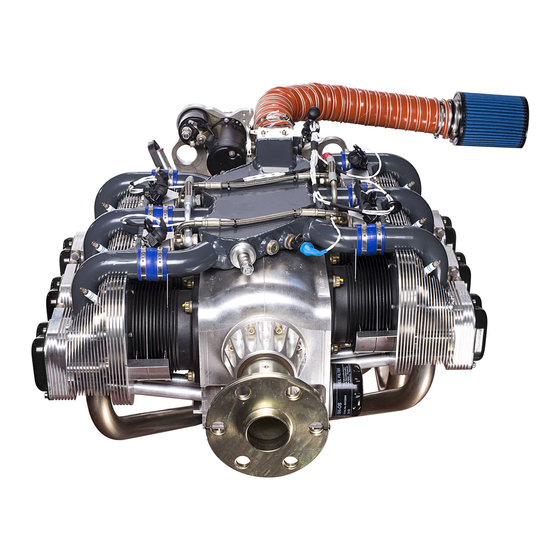
Summarization of Contents
Preface
Remarks
General notes on diagrams, specifications, and other manuals.
Modifications
ULPower's policy on product improvement and changes.
Engine serial number
Importance of indicating the engine serial number for inquiries.
Repeating symbols
Explains symbols used for warnings and attention.
Safety information
General Safety Precautions
Crucial safety advice for engine installation, operation, and potential hazards.
Denomination of cylinders
UL260 / UL350 Cylinder Identification
Diagram showing cylinder numbering for UL260 and UL350 engines.
UL390 / UL520 Cylinder Identification
Diagram showing cylinder numbering for UL390 and UL520 engines.
Description of systems
Lubricant system
Describes the oil pump, filter, and lubrication flow within the engine.
Fuel system
Explains the fuel flow from tanks through pumps and filters to the engine.
Electronic Engine Management system
Details the ECU's role in fuel mixture, timing, and engine control.
Cooling system
Explains air and oil cooling methods and mandatory installation of ducts/oil cooler.
Check light
ECU Sensor Inputs
Explains sensors (CPS, TPS, OTS, ATS, APS) used by the ECU for engine management.
Check Light Functionality
Describes check light behavior on sensor failure and testing procedures.
General operating limits
Speed Limits
Specifies maximum engine speed, recommended prop speed, and idle speeds.
Requirements about RPM Settings
Lists minimum static RPM, takeoff speed, and straight/level speed at WOT.
Running in
Guidelines for breaking in non-aerobatic and aerobatic engines.
Performance (ISA: International standard atmosphere)
Table showing HP and RPM for different engine models under ISA conditions.
Acceleration Limits
Defines limits for engine operation at zero gravity and negative "g" conditions.
Oil Pressure
Specifies normal, max, and min oil pressure ranges.
Oil Level
Details required oil quantities for different engine models and leveling advice.
Oil Temperature
Provides maximum, minimum, and normal operating oil temperatures.
Cylinder head temperature
Specifies maximum and continuous maximum cylinder head temperatures.
EGT
Max EGT value and importance of equal EGTs across cylinders.
ECU environment
Specifies the operating temperature range for the ECU.
Manifold air temperature
Recommended manifold air temperatures for start and flight.
Outside air temperature
Specifies maximum and minimum outside air temperatures for operation.
Relative fuel pressure
Defines max, min, and normal relative fuel pressure.
Deviation from bank angle
Indicates the maximum bank angle for lubrication system warranty.
Electrical power
Minimum required electrical power and warning about using boosters.
Operating media
Fuel
Specifies recommended fuel types (octane ratings) and alternatives.
Lubricants
Recommends specific oil types and notes for aerobatic engines.
Standard operation
Daily/Pre-flight checks
Detailed checklist for pre-flight inspections, including warnings.
Engine start
Step-by-step procedure for starting the engine, including pre-start checks.
Prior to take-off
Covers warming up, idle speed, throttle response, and ignition test.
Take-off
Guidelines for takeoff power settings and duration, emphasizing temperature monitoring.
Cruise
Advice on setting cruise power and respecting operating limits, especially oil temperature.
Abnormal operation
Abnormal running on ignition check
Troubleshooting steps for engine behavior during ignition checks.
Sudden engine stop
Procedures for dealing with sudden engine stoppage, including checks and emergency landings.
Reaching maximum engine speed
How the engine behaves with the RPM limiter and how to react.
Exceeding of max. admissible cylinder head temperature
Actions to take when CHT exceeds limits, including emergency landing.
Exceeding of max. admissible oil temperature
Actions to take when oil temperature exceeds limits, including emergency landing.
Oil pressure below minimum
Critical procedure for low oil pressure, including immediate shutdown or emergency landing.
Exceeding of max. admissible oil pressure
Actions to take when oil pressure exceeds limits, including shutdown.
Relative fuel pressure deviates from normal
Troubleshooting for abnormal fuel pressure and its effects on mixture.
Single CHT and/or EGT drop
Diagnosing issues when CHT/EGT drops in a cylinder, potentially indicating misfiring.
Knocking
How to respond to engine knocking and ensure correct fuel usage.
Low battery voltage
Steps to take for low battery voltage, including reducing electrical load and potential emergency landing.










Need help?
Do you have a question about the UL520iS and is the answer not in the manual?
Questions and answers